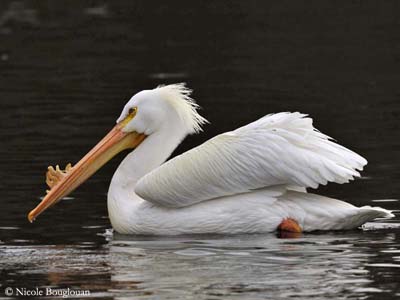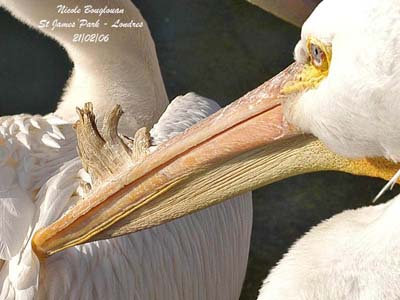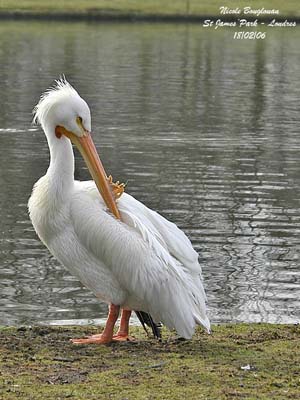
American White Pelican
Pelecanus erythrorhynchos
Pelecaniforme Order - Pelecanidae Family
BIOMETRICS:
Length: 50 to 65 inches; Wingspan: 96 to 114 inches; Weight: 159 to 317 oz.
LONGEVITY: 26 years
DESCRIPTION:
American white Pelican has white plumage, with black primaries and outer secondaries.
American white Pelican has short tail. It has pale yellow crest on head. Bill is bright orange in breeding season with a fibrous plate on upper mandible. This plate sheds after eggs are laid, and crown and nape become greyish.

Bill has a distensible gular pouch. Short legs and webbed feet are orange. Eyes are dark. Bill and legs become duller after breeding season.
Both sexes are similar.
Juvenile is white, with brownish wash on head, neck and upperwings. It is duller than adults. Bill is grey to flesh-coloured.

VOICE: SOUNDS BY XENO-CANTO
American white Pelican is generally silent, except in nesting colonies where chicks utter whining grunts asking for food.
Adults utter low and hoarse display calls.
HABITAT:
American white Pelicans nest and feed in large lakes and ponds of American prairies. In winter, they also are on coastal waters.
Usually, colonies nest on islands or peninsulas, in brackish or freshwater lakes.
RANGE:
American whiter Pelican breeds from western Manitoba and Minnesota, and westward to northern California.
It winters in California, Mexico, and along the Gulf Coast and in Florida.
BEHAVIOUR:
American white Pelicans hunt in flocks. They float on the surface, forming a line or a circle of 10 to 12 birds. They flap wings and bills to scare preys towards the shore, in shallow water. They can also separate and first line drives preys towards second line. And then, pelicans sift through the water with semi open bills, and swallow the fish head first. They may consume about three pounds of fish per day, and food is swallowed for transport to the nest, and not carried in the pouch. It may fish at night, locating the prey by touch.

American white Pelican is a very gregarious bird, and breeds in large colonies.
When migrate, American white Pelicans move diurnally in flocks of up to 200 individuals. They are long distance migrants.
During courtship display, male and female show their bright orange bills. They strut around, bowing and taking short flights to attract a mate.
FLIGHT:
American white Pelicans fly in large flocks, giving an impressive sight when they draw circles downwards on set wings, from great heights.
Their wings move in unison and effortless. After a few wing beats, they sail, forming circles at great elevation. They may also fly in line or in V formation.
American white Pelicans have a graceful strong flight with their elongated necks bent back over bodies.
REPRODUCTION:
American white Pelican breeds in large colonies, on islands or peninsulas, and in undisturbed areas. Nest is built by both adults on the ground, with sticks and twigs, in a shallow depression, lined with dry vegetation, or on a low mound of vegetation matter and earth. The nest is surrounded by a low rim of gravel, soil or plant material.
Female lays 2 chalky white eggs. Incubation lasts about 29 to 36 days, by both parents. Pelican incubate with their webbed feet because they don’t have brood patch or bare skin on belly. Chicks are naked at birth, and they have white down at 10 days old. Both adults tend the altricial chicks, feeding them by regurgitate food, but usually, only one young fledges by nest, at about 17 to 28 days after hatching, and it is still flightless.
Young gather in groups within the colony. They start to migrate at 10 to 11 weeks of age, and only one week after their first flights.
They reach their sexual maturity at three or four years of age, when they develop “nuptial tubercles” or large ridges in their bills, and some ornamental feathers on head.
This species produces one clutch per season, and doesn’t nest again if first clutch is lost.

DIET:
American white Pelican feeds mainly on fish. It may also eat salamanders and crustaceans.
PROTECTION / THREATS / STATUS:
American white Pelican is extremely sensitive to human disturbances on breeding colonies. Adults abandon their nests, exposing eggs and chicks to predators.
Habitat destruction has also contributed to population decline.
Fr: Pelican d’Amérique
All : Nashornpelikan
Esp : Pelícano Norteamericano
Ital : Pellicano bianco americano
Nd : Witte Pelikaan
Russe : Пеликан-Носорог
Sd : Hornpelikan
Text and photographs by Nicole Bouglouan
More photographs
Sources:
All About Birds - Cornell Lab of Ornithology
Wikipedia (Wikipedia, The Free Encyclopedia)
Welcome to WhoZoo (Jill Foley)
What Bird-The ultimate Bird Guide (Mitchell Waite)